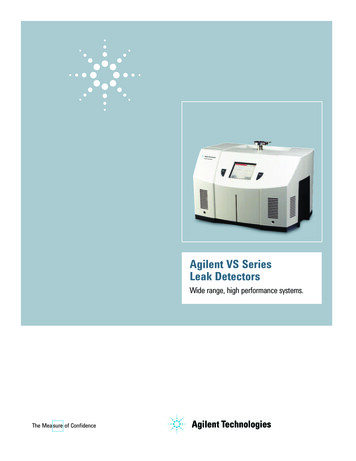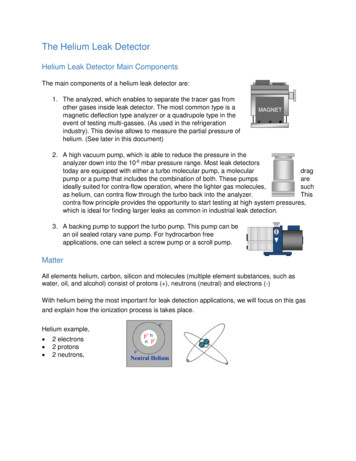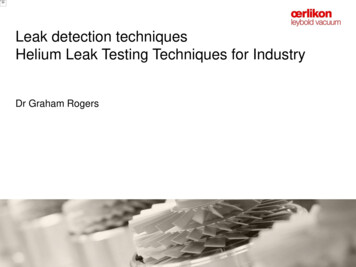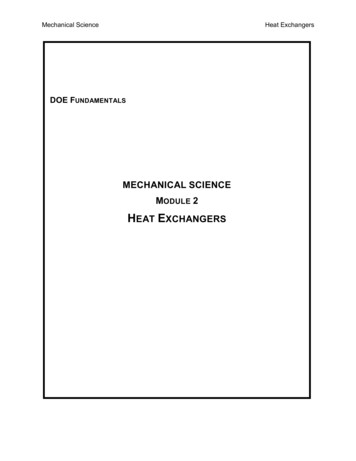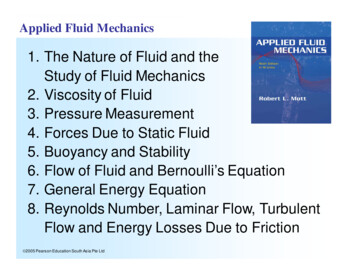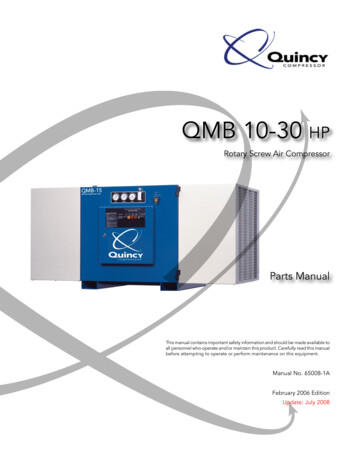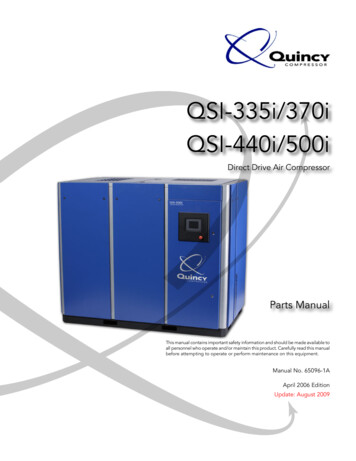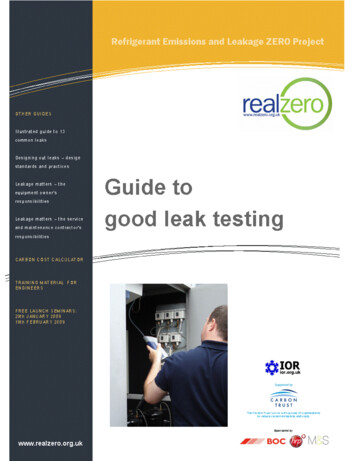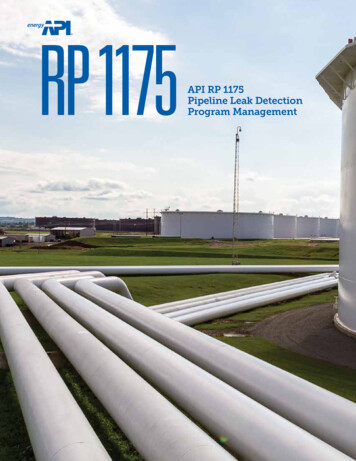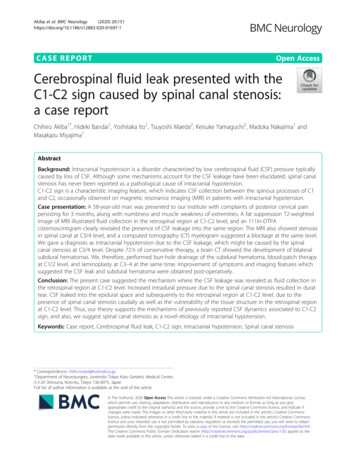
Transcription
Akiba et al. BMC Neurology(2020) SE REPORTOpen AccessCerebrospinal fluid leak presented with theC1-C2 sign caused by spinal canal stenosis:a case reportChihiro Akiba1*, Hideki Bandai1, Yoshitaka Ito1, Tsuyoshi Maeda2, Keisuke Yamaguchi2, Madoka Nakajima1 andMasakazu Miyajima1AbstractBackground: Intracranial hypotension is a disorder characterized by low cerebrospinal fluid (CSF) pressure typicallycaused by loss of CSF. Although some mechanisms account for the CSF leakage have been elucidated, spinal canalstenosis has never been reported as a pathological cause of intracranial hypotension.C1-C2 sign is a characteristic imaging feature, which indicates CSF collection between the spinous processes of C1and C2, occasionally observed on magnetic resonance imaging (MRI) in patients with intracranial hypotension.Case presentation: A 58-year-old man was presented to our institute with complaints of posterior cervical painpersisting for 3 months, along with numbness and muscle weakness of extremities. A fat suppression T2-weightedimage of MRI illustrated fluid collection in the retrospinal region at C1-C2 level, and an 111In-DTPAcisternoscintigram clearly revealed the presence of CSF leakage into the same region. The MRI also showed stenosisin spinal canal at C3/4 level, and a computed tomography (CT) myelogram suggested a blockage at the same level.We gave a diagnosis as intracranial hypotension due to the CSF leakage, which might be caused by the spinalcanal stenosis at C3/4 level. Despite 72 h of conservative therapy, a brain CT showed the development of bilateralsubdural hematomas. We, therefore, performed burr-hole drainage of the subdural hematoma, blood-patch therapyat C1/2 level, and laminoplasty at C3–4 at the same time. Improvement of symptoms and imaging features whichsuggested the CSF leak and subdural hematoma were obtained post-operatively.Conclusion: The present case suggested the mechanism where the CSF leakage was revealed as fluid collection inthe retrospinal region at C1-C2 level. Increased intradural pressure due to the spinal canal stenosis resulted in duraltear. CSF leaked into the epidural space and subsequently to the retrospinal region at C1-C2 level, due to thepresence of spinal canal stenosis caudally as well as the vulnerability of the tissue structure in the retrospinal regionat C1-C2 level. Thus, our theory supports the mechanisms of previously reported CSF dynamics associated to C1-C2sign, and also, we suggest spinal canal stenosis as a novel etiology of intracranial hypotension.Keywords: Case report, Cerebrospinal fluid leak, C1-C2 sign, Intracranial hypotension, Spinal canal stenosis* Correspondence: chihi-rocket@hotmail.co.jp1Department of Neurosurgery, Juntendo Tokyo Koto Geriatric Medical Center,3-3-20 Shinsuna, Koto-ku, Tokyo 136-0075, JapanFull list of author information is available at the end of the article The Author(s). 2020 Open Access This article is licensed under a Creative Commons Attribution 4.0 International License,which permits use, sharing, adaptation, distribution and reproduction in any medium or format, as long as you giveappropriate credit to the original author(s) and the source, provide a link to the Creative Commons licence, and indicate ifchanges were made. The images or other third party material in this article are included in the article's Creative Commonslicence, unless indicated otherwise in a credit line to the material. If material is not included in the article's Creative Commonslicence and your intended use is not permitted by statutory regulation or exceeds the permitted use, you will need to obtainpermission directly from the copyright holder. To view a copy of this licence, visit http://creativecommons.org/licenses/by/4.0/.The Creative Commons Public Domain Dedication waiver ) applies to thedata made available in this article, unless otherwise stated in a credit line to the data.
Akiba et al. BMC Neurology(2020) 20:151BackgroundIntracranial hypotension has gained increasing recognition over the past 20 years [1–4], as a disorder of lowcerebrospinal fluid (CSF) pressure characterized by postural headache, brain sagging and chronic subdural hematomas [5–7]. Intracranial hypotension is typicallycaused by loss of CSF through nerve root sleeve diverticulum, dural defect due to osteophyte spur or CSFvenous fistula in the thoracic or lumbar spine; however,underlying pathophysiology remains incompletely understood [4]. Further, to the best of our knowledge, spinalcanal stenosis has never been reported as a pathologicalcause of intracranial hypotension.C1-C2 sign is a characteristic imaging feature, which indicates CSF collection in retrospinal soft tissue betweenthe spinous processes of C1 and C2 levels, occasionallyobserved on magnetic resonance imaging (MRI) in patients with intracranial hypotension [8–10]. An interestingand important consideration of this sign is that the retrospinal point at C1-C2 level exactly indicates the site ofCSF leakage (i.e. the site of dural tear) in some patients[11, 12], but not necessarily indicates the site of CSF leakage (i.e. the site of dural tear) in other patients [8, 13]. Thisdiscrepancy comes from dynamics of the leaked CSF inthe spinal canal. In other words, the site of dural tearwhich makes the connection between intra- and epiduralspaces is possibly different from the site of tear on theposterior atlantoaxial membrane at C1-C2 level whichmakes fluid collection in the retrospinal tissue.We have recently encountered a patient with intracranial hypotension in association with spinal canal stenosisas its potential etiological factor, and were presentedwith a characteristic imaging with the C1-C2 sign. Moreover, we performed combined therapies which includeburr-hole drainage of the subdural hematoma, bloodpatch therapy and laminoplasty. Here, we report suggestive strategies of diagnosis and treatment of intracranial hypotension.Case presentationA 58-year-old Japanese man was presented to our outpatient unit complaining of posterior cervical pain. Thepain firstly appeared 3 months before the first contact tous without any particular triggers such as trauma. Hewas relieved from the pain when lying flat; however, hekept working as a plumber and the pain got worse overthe time period. A brain computed tomography (CT)was performed 1.5 months after the onset in anotherclinic and it revealed bilateral subdural effusion (Fig. 1),still, no treatment was given at this point. Later on,when he was presented to our hospital, numbness andweakness of extremities also appeared in addition to theprogressive posterior cervical pain as well as headache.Page 2 of 5Fig. 1 Subdural effusion at the onse. Bilateral subdural effusion wasdemonstrated by T2-weighted image of brain magnetic resonanceimaging (MRI)He had a medical history of hemorrhoid and no particular familial history.The patient admitted to our department soon after theinitial contact. A hand-held dynamometer revealed hisweakened grip strength of both of his hands by 30–40kg. He was also presented with bilateral muscle weakness in his lower extremities which was 4 of 5 in theManual Muscle Test (MMT) score [14], as well as sensory disturbances in his forearms, hands and the posterior surface of thighs on both sides. His JapaneseOrthopedic Association (JOA) score [15] was 13.5.A fat suppression T2-weighted MRI without gadolinium enhancement of the cervical spine illustrated a fluidcollection in the soft tissue spaces of the retrospinal region at C1-C2 level (Fig. 2). Additionally, it demonstrated spinal canal stenosis at C3/4 level. Subsequently,a cisternoscintigram and a CT myelogram were performed with intradural injection of 111In-DTPA (NihonMediphysics, Tokyo, Japan) and Omnipaque 240 (Daiichi-Sankyo, Tokyo, Japan), an iodine contrast agent,through a lumber puncture. The 111In-DTPA cisternoscintigram clearly revealed CSF leakage into the retrospinal region at C1-C2 level, as well as blockage of the111In-DTPA at lower level of the cervical spinal canal(Fig. 3). Furthermore, the CT myelogram also suggestedblockage at lower level of the cervical spinal canal;though it did not demonstrated the sign of CSF at C1C2 level or any other sites (Fig. 4).72 h of conservative therapy, including bed rest, intravenous fluid hydration, muscle relaxants and nonsteroidal anti-inflammatory drugs, was ineffective at
Akiba et al. BMC Neurology(2020) 20:151Fig. 2 C1-C2 sign. A saggital view of T2-weighted fat suppressionimage of magnetic resonance imaging (MRI) in the cervical levelrevealed fluid collection in the retrospinal region at C1-C2 level.Additionally, a spinal canal stenosis at C3/4 level was also demonstratedimproving his symptoms, and the re-examination ofbrain CT showed progression of the bilateral subduraleffusions to bilateral subdural hematomas (Fig. 5).After reviewing of his imaging data and confirmationthat no other cause presented in development of subdural hematoma along with careful discussions, we gavea diagnosis of intracranial hypotension due to the CSFleakage from C1-C2 level, which might be caused byspinal canal stenosis at C3/4 level. We, therefore, performed burr-hole drainage of the subdural hematoma,Fig. 3 CSF leakage detected by cisternoscintigram. A saggital viewof cisternoscintigram in the cervical level demonstrated CSF leak inthe retrospinal region at C1-C2 levelPage 3 of 5Fig. 4 CSF blockage detected by computed tomography (CT)myelogram. A saggital view of CT myelogram illustrated CSFblockage due to the spinal canal stenosis at C3/4 level. On the otherhand, no sign of CSF leak was demonstratedblood-patch therapy at C1/2 level and laminoplasty atC3–4, at the same time. In the laminoplasty, CSF flewout from the epidural space subsequently to the openingof lamina, and after sufficient decompression, the CSFflow was reduced in the operation field, withoutFig. 5 Bilateral subdural hematoma. Subdural effusion progressed tothe bilateral subdural hematoma
Akiba et al. BMC Neurology(2020) 20:151detection and restoration of dural tear (Video). In theblood-patch therapy, an epidural catheter was insertedfrom the surgical field at C3–4 level to C1-C2 levelunder x-ray fluoroscopy observation. Approximately 5ml of autologous blood sampled from patient’s peripheral vein was injected to the epidural site at C1-C2 leveland the blood-patch therapy was achieved.Postoperative response was significantly favorable. Hissymptoms completely improved and the imaging featuresthat suggested CSF leak and intracranial hypotension disappeared (Fig. 6). He discharged on postoperative day 10with satisfaction, and no signs of recurrence were observed for 5 months postoperatively up to this point. Thepatient returned to his daily life as well as his occupation.Discussion and conclusionWe report a case of intracranial hypotension which waspotentially caused by spinal canal stenosis with C1-C2sign on MRI fat suppression T2-weighted image. TheC1-C2 sign in the present case deserves special attention. This sign is typically seen as a focal area of fluidlike signal intensity on MRI and as a CSF collection between the spinous processes of C1 and C2 on CT myelograms or a cisternoscintigrams. These imaging featuresare found in 12–67% of the patients with intracranialhypotension [8, 9, 13, 16]. Our imaging tests includedone discrepancy where the cisternoscintigram revealedthe CSF leakage at C1-C2 level, although, the CT myelogram did not. It could be because of the difference ofFig. 6 Postoperative imaging. Postoperative saggital view of T2weighted fat-suppressed magnetic resonance imaging (MRI) in thecervical level revealed disappearing of the fluid collection in theretrospinal region at C1-C2 level. Also, the spinal canal stenosis atC3/4 level was treatedPage 4 of 5molecular weights between 111In-DTPA and Omnipaque 240 , which were approximately 545.29 and 821.4,respectively. The smaller molecular weight allowed111In-DTPA to go up through the blockage due to thecanal stenosis, while Omnipaque 240 with bigger molecular weight was stuck.Interestingly, though, it should be noted that C1-C2sign does not necessarily denote the exact site of CSFleakage; hence, it has also been called as C1–C2 false localizing sign [8, 10]. Schievink et al. succeeded to reproduce the C1-C2 sign by contrasting epidural space inpatients with intracranial hypotension presented withC1-C2 sign, which suggested that CSF leaked from duraldamage into epidural space flew out from the spinalcanal and diffusely expanded to the soft tissue of dorsalregion of C1-C2. In fact, the actual leakage site reportedwas caudal to the fluid collections and most often originated in the lower cervical and the thoracic spine intheir report. They postulated the mechanism that theenlarged epidural space due to the CSF leakage providesa capacious pathway for the leaked CSF to travel alongthe spinal canal, and the C1-C2 level may be the mostparticularly vulnerable escape site for the CSF into thesoft tissues because of the absence of epidural fat, themobility of this segment, the lack of bone support, orthe loose connective tissues [8]. In support, it is reportedthat the posterior atlantoaxial membrane at C1-C2 levelis a vulnerable site because it lacks the yellow ligamentand epidural fat [17], and the retrospinal region betweenthe myodural bridges of rectus capitis posterior majorand obliquus capitis inferior are areas rich in loose connective tissues [18]. Furthermore, Klarica et al. demonstrated the cervical subarachnoid space was a site forbuffering spinal CSF pressure by its elasticity, using anexperimental model [19]. They showed CSF redistribution under the vertical head-down position, expandingcervical subarachnoid space, while lumber subarachnoidspace was narrowed without any changes of the cranialvolume. This phenomenon helps us to explain that thecervical subarachnoid space plays a role in control spinalCSF pressure by expanding and shrinking. In support, itis also suggested that the epidural lymphatics are welldeveloped on the dorsal side of the lower cervical spinaldura mater and may function as an absorptive pathwayfor the CSF from the subarachnoidal space [20].Another novel finding in the case is that spinal canalstenosis could be a pathological cause of CSF leakage andhence, intracranial hypotension. The suggested mechanism from the present case is that the spinal canal stenosisand straining could lead to increased intradural pressurewhich eventually resulted in the dural tear. Subsequently,the CSF leaked into the epidural space and later escapedto the retrospinal region at C1-C2 level, because of its vulnerability; and dysfunction of CSF pressure regulation in
Akiba et al. BMC Neurology(2020) 20:151cervical subarachnoid space contributed by the obstruction of the caudal epidural space resulting from spinalcanal stenosis. Thus, our theory could fit and support themechanism of CSF dynamics in the mechanism of C1-C2presentation advocated by Schievink et al. [8], and thecapability of cervical subarachnoid space in regulatingCSF pressure demonstrated by Klarica et al. [19] andMiura et al. [20]. In conclusion, reteospinal region at C1C2 level is a frequent site of CSF collection due to theCSF leakage from any levels of the spine, because of itsanatomical and functional characteristics. We also suggested the spinal canal stenosis as a novel etiology of intracranial hypotension.Supplementary informationSupplementary information accompanies this paper at nal file 1. Microscopic pictures of the laminoplasty. Legend: Onthe left side of the screen indicates the cranial side and the right sideindicates the caudal side. CSF flew out from the epidural spacesubsequently to the opening of lamina, and after sufficientdecompression, the CSF flow was reduced in the operation field, withoutdetection and restoration of dural tear.Additional file 2.AbbreviationsCSF: Cerebrocspinal fluid; MRI: Magnetic resonance imaging; CT: ComputedtomographyAcknowledgementsThe authors thank Ken Suzuki and Norio Someya for their support in theimaging analyses which is the key factor in this paper.Authors’ contributionsCA was responsible for obtaining consent, acquiring the data and drafting themanuscript. HB, YI, and MM established the clinical diagnosis with CA andassisted in drafting and critically revised the manuscript. MN was responsible fordiscussion with ethics committee. All authors were contributed to the surgery,and especially, TM and KY helped performing the blood patch therapy. Allauthors approved the final version of the manuscript.FundingWe acknowledge funding from the Ministry of Health, Labor, and Welfare ofJapan (2017-Nanchi-General-037) and in part by Grants-in-Aid for ScientificResearch (grant numbers 16KK0187, 17 K10908, and 18H02916) from theJapan Society for the Promotion of Science. The funds are used for Englishproofreading and for the contribution fee.Availability of data and materialsThe datasets used and/or analyzed in the current study are available fromthe corresponding author on reasonable request.Ethics approval and consent to participateThis study was reviewed and approved by the Ethics Committee of JuntendoTokyo Koto Geriatric Medical Center. Patient was not required to provideinformed consent because the analysis used anonymous clinical data that wereobtained after patient agreed to examinations and treatment by verbal andwritten consent. This study strictly followed the care guidelines.Consent for publicationVerbal and written consent has been obtained from the patient for thepublication of this case report and all accompanying images.Page 5 of 5Competing interestsThe authors declare that they have no competing interests.Author detailsDepartment of Neurosurgery, Juntendo Tokyo Koto Geriatric Medical Center,3-3-20 Shinsuna, Koto-ku, Tokyo 136-0075, Japan. 2Department ofAnesthesiology, Juntendo Tokyo Koto Geriatric Medical Center, 3-3-20Shinsuna, Koto-ku, Tokyo, 136-0075 Japan, Japan.1Received: 17 November 2019 Accepted: 26 March 2020References1. Gordon RE, Moser FG, Pressman BD, Young W. Resolution ofpachymeningeal enhancement following dural puncture and blood patch.Neuroradiology. 1995;37(7):557–8.2. Schievink WI. Spontaneous spinal cerebrospinal fluid leaks and intracranialhypotension. JAMA. 2006;17:295(19):2286–96.3. Mokri B. Spontaneous CSF leaks: low CSF volume syndromes. Neurol Clin.2014;32(2):397–22.4. Schievink WI, Maya MM, Jean-Pierre S, Nuno M, Prasad RS, Moser FG. Aclassification system of spontaneous spinal CSF leaks. Neurology. 2016;16:87(7):673–9.5. Mokri B. Spontaneous low pressure, low CSF volume headaches:spontaneous CSF leaks. Headache. 2013;53(7):1034–53.6. Wicklund MR, Mokri B, Drubach DA, Boeve BF, Parisi JE, Josephs KA.Frontotemporal brain sagging syndrome: an SIH-like presentationmimicking FTD. Neurology. 2011;19:76(16):1377–82.7. Schievink WI, Ebersold MJ, Atkinson JL. Roller-coaster headache due tospinal cerebrospinal fluid leak. Lancet. 1996;18:347(9012):1409.8. Schievink WI, Maya MM, Tourje J. False localizing sign of C1-2 cerebrospinal fluidleak in spontaneous intracranial hypotension. J Neurosurg. 2004;100(4):639–44.9. Medina JH, Abrams K, Falcone S, Bhatia RG. Spinal imaging findings inspontaneous intracranial hypotension. AJR Am J Roentgenol. 2010;195(2):459–64.10. Morgan JT, Scumpia AJ, Johnson AA, Schneider SJ. Case report: spontaneousintracranial hypotension in association with the presence of a false localizingC1-C2 cerebrospinal fluid leak. Surg Neurol. 2008;70(5):539–44.11. Walker DG. Refractory headache due to spontaneous intracranialhypotension from a CSF leak at C1-2. J Clin Neurosci. 2003;10(4):482–5.12. Kamada M, Fujita Y, Ishii R, Endoh S. Spontaneous intracranial hypotensionsuccessfully treated by epidural patching with fibrin glue. Headache. 2000;40(10):844–7.13. Yousry I, Förderreuther S, Moriggl B, Holtmannspötter M, Naidich TP,Straube A, Yousry TA. Cervical MR imaging in postural headache: MR signsand pathophysiological implications. AJNR Am J Neuroradiol. 2001;22(7):1239–50.14. Hislop HJ, Montgomery J. Daniels and Worthingham’s muscle testing:techniques of manual examination. 7th ed. Philadelphia: Saunders Co; 2002.15. Yonenobu K, Abumi K, Nagata K, Taketomi E, Ueyama K. Interobserver andintraobserver reliability of the japanese orthopaedic association scoringsystem for evaluation of cervical compression myelopathy. Spine (Phila Pa1976). 2001;26(17):1890–5.16. Tsai PH, Fuh JL, Lirng JF, Wang SJ. Heavily T2-weighted MR myelography inpatients with spontaneous intracranial hypotension: a case-control study.Cephalalgia. 2007;27(8):929–34.17. Ramsey RH. The anatomy of the ligamenta flava. Orthop Realat Res. 1966;44:129–40.18. Scali F, Pontell ME, Welk AB, Malmstrom TK, Marshall E, Kettner NW.Magnetic resonance imaging investigation of the atlanto-axial interspace.Clin Anat. 2013;26(4):444–9.19. Klarica M, Radoš M, Erceg G, Petošić A, Jurjević I, Orešković D. The influenceof body position on cerebrospinal fl uid pressure gradient and movementin cats with normal and impaired craniospinal communication. PLoS ONE.2014;9(4):e95229. https://doi.org/10.1371/journal.pone.0095229.20. Miura M, Kato S, von Ludinghause M. Lymphatic drainage of the cerebrospinalfluid from monkey spinal meninges with special reference to the distributionof the epidural lymphatics. Arch Histol Cytol. 1998;61(3):277–86.Publisher’s NoteSpringer Nature remains neutral with regard to jurisdictional claims inpublished maps and institutional affiliations.
cerebrospinal fluid (CSF) pressure characterized by pos-tural headache, brain sagging and chronic subdural he-matomas [5-7]. Intracranial hypotension is typically caused by loss of CSF through nerve root sleeve diver-ticulum, dural defect due to osteophyte spur or CSF-venous fistula in the thoracic or lumbar spine; however,
